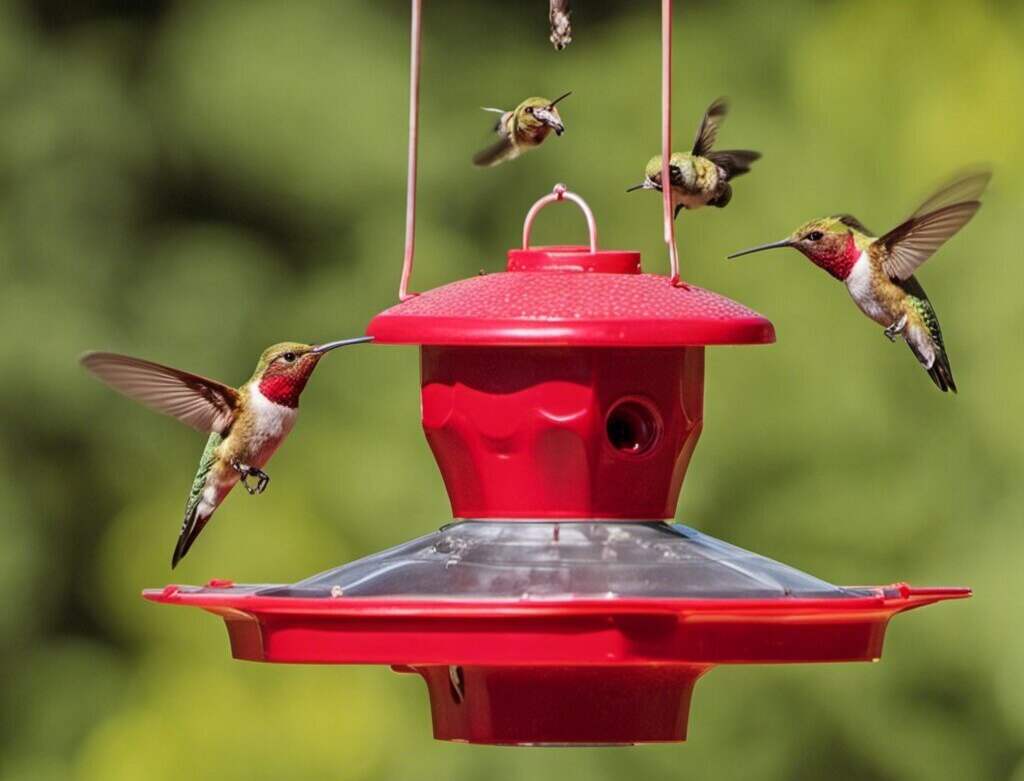If you’re a bird enthusiast, you probably know how exciting it is to attract hummingbirds to your feeder. However, bees can be a nuisance, making it difficult for the birds to access their food and causing a disturbance.
Fortunately, there are several methods and products you can use to prevent bees from accessing your hummingbird feeder and create a buzz-free environment for your feathered friends.
Table of Contents
- 1 Key Takeaways
- 2 How to Keep Bees Off Hummingbird Feeder
- 3 Understanding Bees and Their Attraction to Hummingbird Feeders
- 4 Choosing Bee-Proof Hummingbird Feeders
- 5 Installing Bee Guards on Your Hummingbird Feeder
- 6 Using Natural Deterrents to Repel Bees
- 7 Proper Placement of Hummingbird Feeders
- 8 Attracting Hummingbirds Away from Bees
- 9 Regular Maintenance and Cleaning of Hummingbird Feeders
- 10 Additional Tips and Tricks for Bee-Free Hummingbird Feeding
- 11 Considering the Importance of Bees and Pollinator-Friendly Practices
- 12 Troubleshooting Bee Problems on Hummingbird Feeders
- 13 Conclusion
- 14 FAQs: How to Keep Bees Off Hummingbird Feeder?
- 14.1 Why are bees attracted to hummingbird feeders?
- 14.2 Q: What are bee-proof hummingbird feeders?
- 14.3 How do I install bee guards on my hummingbird feeder?
- 14.4 Are there natural deterrents to repel bees from hummingbird feeders?
- 14.5 Can the placement of my hummingbird feeder minimize bee activity?
- 14.6 How can I attract hummingbirds away from bees?
- 14.7 How often should I clean my hummingbird feeder?
- 14.8 How can I prevent wasps from becoming a nuisance on my hummingbird feeder?
- 14.9 What are some additional tips to deter bees from hummingbird feeders?
- 14.10 How can I support pollinators while keeping bees away from my hummingbird feeder?
- 14.11 What should I do if I still encounter persistent bee problems on my hummingbird feeder?
- 15 Author
Key Takeaways
- Bees are attracted to the sweet nectar in hummingbird feeders, making it difficult for hummingbirds to access their food.
- Investing in a bee-proof feeder or adding bee guards to your existing feeder can effectively keep bees away.
- Using natural deterrents, proper placement of the feeder, and providing alternative food sources can also minimize bee activity.
- Regular maintenance and cleaning of the feeder is crucial for keeping it bee-resistant.
- Remember the importance of bees as pollinators and consider pollinator-friendly practices in your garden.
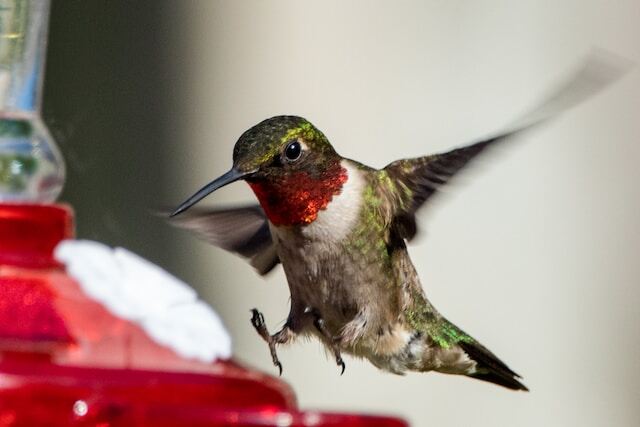
How to Keep Bees Off Hummingbird Feeder
If you want to keep bees off your hummingbird feeder, there are a few things you can do. First, try moving the feeder to a new location that is not in direct sunlight. Bees are attracted to the warmth and brightness of the sun, so moving the feeder to a shaded area can help keep them away.
You can also try using a feeder with bee guards or other barriers that prevent bees from accessing the nectar. Another option is to dilute the nectar by adding more water, as bees prefer a sweeter solution.
Finally, consider using a wasp trap or creating your own using a small jar filled with a sweet liquid, such as soda or juice, with an opening in the lid for the bees to enter.
However, it’s important to note that bees are important pollinators and killing them is not recommended. Instead, try using non-lethal methods to keep them away from your hummingbird feeder.
Understanding Bees and Their Attraction to Hummingbird Feeders
Before we delve into the solutions, it is important to have a thorough understanding of why bees are attracted to hummingbird feeders. Detailed notes show that bees are naturally drawn to the sweet scent of nectar, making the sugar content of hummingbird feeders an irresistible source for them.
Additionally, the bright colors of the feeder and the movement of the birds create a visual attraction for bees. By understanding their behavior, we can implement effective strategies to deter bees.
Did you know? Bees are naturally attracted to bright colors, particularly yellow and blue. Consider using feeders that are red or orange instead.
| Key points about bees and hummingbird feeders |
|---|
| Bees are attracted to the sweet nectar in hummingbird feeders because of their natural instinct to seek out sugar. |
| The colors of the feeder and the movement of the birds also act as additional attractions for bees. |
| Bees are especially attracted to yellow and blue colors, so consider using feeders that are red or orange instead. |
Dealing with bees on hummingbird feeders
While bees are important pollinators, they can become a nuisance when they monopolize hummingbird feeders. In the following sections, we will explore several bee-proofing methods, such as bee-proof feeders, bee guards, natural deterrents, and proper feeder placement.
By using a combination of these strategies, you can create a safe and welcoming environment for hummingbirds while keeping bees at bay.
Choosing Bee-Proof Hummingbird Feeders
If you want to keep bees off your hummingbird feeder, investing in a bee-proof feeder is one of the most effective solutions. These feeders are specifically designed to prevent bees from accessing the nectar while still allowing hummingbirds to feed.
When choosing a bee-proof feeder, there are several important features to consider:
- Bee guards: Look for feeders with bee guards on the feeding ports. These guards create a barrier that bees cannot penetrate, allowing only hummingbirds to access the nectar.
- Specially designed feeding ports: Some feeders are designed with longer feeding ports or smaller bee-proof openings to allow hummingbirds easy access while keeping bees out.
- Non-yellow color: Bees are naturally attracted to yellow, so choosing a feeder in a different color can help deter them.
- Large capacity: Since bees are attracted to the scent of nectar, a feeder with a large capacity and fewer refills can help reduce bee activity.
Here are some top-rated bee-proof hummingbird feeders to consider:
| Feeder | Features |
|---|---|
| Aspects 12oz HummZinger Ultra | Built-in ant moat, raised flowers to divert rainwater, bee-resistant ports |
| Perky-Pet 16oz Glass Hummingbird Feeder | Bee guards, four feeding ports, attractive red color |
| Mosaic Birds M045-200 Hummble Slim Hummingbird Feeder | Hand-blown glass with unique mosaic design, bee and wasp proof, dishwasher safe |
Investing in a bee-proof hummingbird feeder is a long-term solution to keep bees away from your feeder and allow hummingbirds to feed undisturbed.
Installing Bee Guards on Your Hummingbird Feeder
One method to prevent bees from accessing the nectar in your hummingbird feeder is by installing bee guards on the feeding ports. Bee guards are small attachments that create a physical barrier that bees cannot penetrate. This allows only hummingbirds to access the nectar, ensuring that bees stay away from your feeder.
When choosing bee guards, it is important to ensure that they fit securely on your feeder’s feeding ports. Some feeders come with bee guards included, while others require separate purchase.
To install bee guards on your hummingbird feeder, follow these steps:
- Clean the feeding ports of your feeder to remove any debris or residue that may interfere with the bee guards.
- Attach the bee guards to the feeding ports according to the manufacturer’s instructions.
- Ensure that the bee guards fit snugly and do not obstruct the feeding ports.
It is important to note that bees can still access the nectar if they find other openings in the feeder. Therefore, bee guards should be used in conjunction with other bee-resistant strategies to create a bee-free zone for hummingbirds.
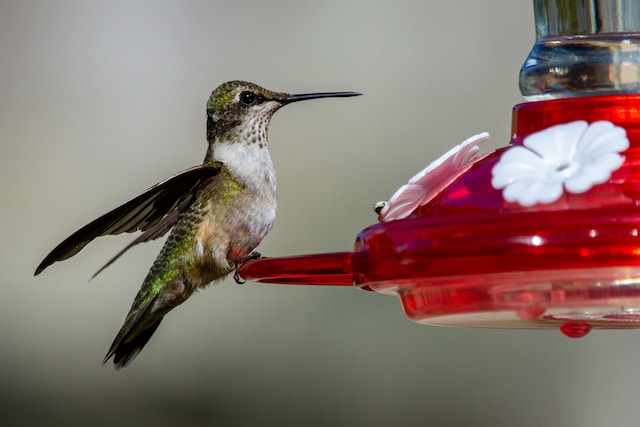
Using Natural Deterrents to Repel Bees
If you’re looking for a natural solution to keep bees away from your hummingbird feeder, there are several options to explore. By utilizing natural deterrents, you can create an environment that bees find unappealing.
Essential Oils
Essential oils are a popular and effective way to deter bees from hummingbird feeders. Peppermint oil, cinnamon oil, and clove oil are all known to repel bees. Simply mix a few drops of the oil with water and spray it around the feeder. Be careful not to spray the mixture directly on the feeder or the nectar.
Vinegar
Vinegar is a natural bee repellent that can be used around hummingbird feeders. Mix equal parts vinegar and water in a spray bottle and spray the solution in the area around the feeder. Be sure to avoid spraying the mixture on the feeder or the nectar as it can be harmful to hummingbirds.
Water-Filled Bags
Water-filled bags can also be used to deter bees from hummingbird feeders. Fill a clear plastic bag with water and hang it near the hummingbird feeder. The reflection of light on the water acts as a deterrent to bees.
It’s important to note that while natural deterrents are effective, they may not be as long-lasting as other methods. You may need to reapply the natural deterrents frequently to maintain their effectiveness.
Tips to Deter Bees from Hummingbird Feeders
In addition to using natural deterrents, there are several other tips you can try to deter bees from your hummingbird feeder. Here are some things to consider:
- Keep the feeder in a shaded area. Bees are typically more active in sunny areas.
- Move the feeder away from other food sources that may attract bees, such as flowers or fruit trees.
- Clean up any spilled nectar or debris around the feeder, as this can attract bees.
- Consider using bee guards on the feeding ports of the hummingbird feeder to prevent bees from accessing the nectar.
By using these tips and natural deterrents, you can create a bee-free environment for your hummingbirds to enjoy.
Proper Placement of Hummingbird Feeders
One of the most effective ways to prevent bees from accessing your hummingbird feeder is to properly place it in a strategic location. Here are some tips to deter bees from your hummingbird feeders:
- Place the feeder in a shaded area to reduce the attraction of bees to the bright colors of the feeder.
- Hang the feeder in a location with little to no wind. When there is wind, the sweet smell of nectar can drift, and bees can be attracted from a distance.
- Place the feeder in proximity to bee-friendly flowers and other sources of nectar. This can provide an alternative food source for bees and may decrease their dependence on the hummingbird feeder.
By following these tips, you can minimize the attraction of bees to your hummingbird feeder and create a more bee-resistant environment for your feathered friends.
Attracting Hummingbirds Away from Bees
One effective way to prevent bees from accessing hummingbird feeders is to attract the birds away from them. By offering alternative nectar sources, you can keep the birds satisfied and reduce their reliance on the feeders. Here are some tips to help you lure hummingbirds away from bees:
- Plant bee-friendly flowers around your yard to provide natural nectar sources. Some good options include sage, bee balm, and salvia.
- Set up additional hummingbird feeders in different areas of your yard to distribute the bird activity and reduce crowding.
- Use brightly colored ribbons or tape to flutter in the breeze near the feeders. This will attract the hummingbirds and deter bees.
By employing these tactics, you can create a bee-free environment for your hummingbirds to flourish.
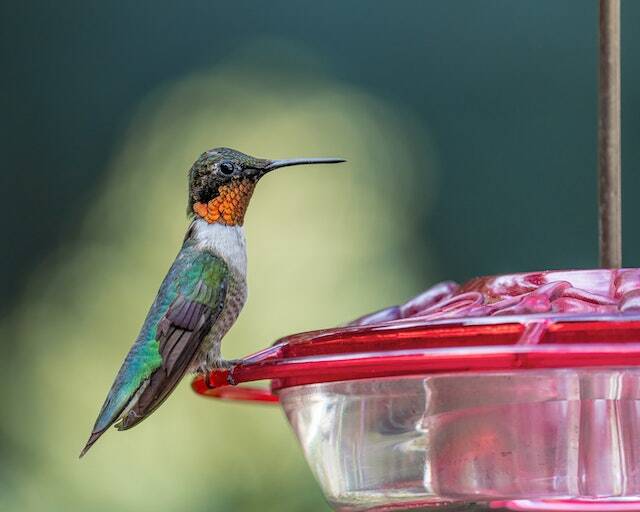
Regular Maintenance and Cleaning of Hummingbird Feeders
Proper maintenance and cleaning of your hummingbird feeder is essential for keeping it bee-resistant and ensuring its effectiveness. Here are some guidelines:
- Clean your feeder at least once a week, or more frequently during hot weather.
- Use a solution of one part vinegar to four parts water to clean the feeder.
- Make sure to disassemble all parts of the feeder, including the feeding ports, and clean them thoroughly.
- Rinse the feeder with hot water and allow it to air dry before refilling.
Aside from bees, wasps can also be a nuisance on hummingbird feeders. Here are some tips to control wasps:
- Choose feeders with built-in wasp guards to prevent them from accessing the nectar.
- Hang the feeder in a shaded area, as wasps are less active in cooler temperatures.
- Use decoy wasp nests to deter them from the area.
- Avoid using sweet-smelling soaps or perfumes when handling the feeder, as this can attract wasps.
Additional Tips and Tricks for Bee-Free Hummingbird Feeding
If you still find bees hovering around your hummingbird feeder, there are additional tips and tricks to try. Here are some effective methods to consider:
Create a Decoy Feeder
One way to divert bees away from your hummingbird feeder is to create a decoy feeder. Fill a small container with a mixture of sugar and water and hang it away from your hummingbird feeder. Bees will be drawn to the decoy feeder, leaving the main feeder bee-free.
Construct a Physical Barrier
You can also create a physical barrier around your hummingbird feeder to keep bees away. Cover the feeder with a mesh netting or use a dome-shaped protector over the feeder. This will prevent bees from accessing the nectar while still allowing hummingbirds to feed.
Employ Natural Bee Repellents
Another natural bee repellent to try is cinnamon. Sprinkling cinnamon near your feeder can mask the sweet scent of nectar and discourage bees from visiting. You can also try using mint and eucalyptus essential oils as a natural deterrent. Make a mixture of water and a few drops of either oil and spray it around the feeder.
Consider Extracting the Nectar
If all else fails, you can try extracting the nectar from your feeder temporarily. This will allow the bees to move on to other food sources while giving the hummingbirds time to find alternative nectar sources. Once the bees have left, you can refill the feeder and resume feeding the hummingbirds.
With these additional tips and tricks, you can create a bee-free environment for your hummingbird feeder.
Considering the Importance of Bees and Pollinator-Friendly Practices
While it is important to keep bees away from your hummingbird feeder, it is crucial to remember their importance as pollinators. Bees play a vital role in ecosystems by pollinating plants, which in turn produce fruits, vegetables, and other food sources. Without them, our food supply would be severely depleted.
Therefore, it is essential to support bees and other pollinators by practicing pollinator-friendly gardening. This includes incorporating a variety of bee-friendly plants into your garden, avoiding the use of pesticides, and providing nesting places for bees. By creating a welcoming environment for bees, you can help support their populations and ensure their continued contribution to the ecosystem.
Detailed Notes: Keeping bees away from your hummingbird feeder does not mean that bees should be avoided altogether. Bees play a crucial role in pollination, and their populations have been declining in recent years due to habitat loss, pesticide use, and disease. Supporting bees and other pollinators not only benefits their populations but also has a positive impact on the environment as a whole. Therefore, it is important to practice pollinator-friendly gardening and support the role of bees in the ecosystem.
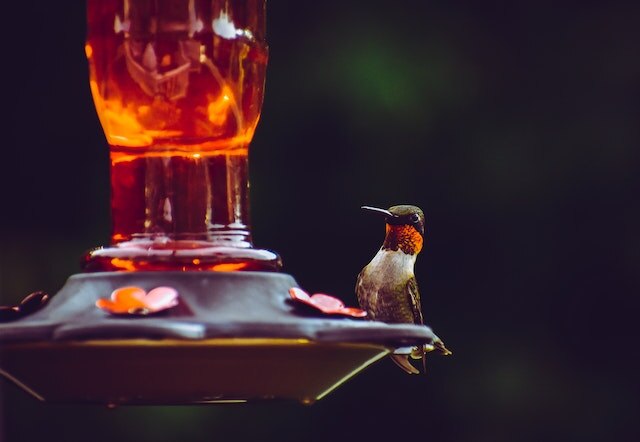
Troubleshooting Bee Problems on Hummingbird Feeders
Despite following the previous tips and tricks, you may still experience bee problems on your hummingbird feeder. Here are some common issues and their solutions:
- Bees are still accessing the feeder: If bees are still finding a way to access the feeder, consider purchasing additional bee guards or creating a physical barrier such as a screen or mesh cloth over the feeder.
- Hummingbirds are avoiding the feeder: If the hummingbirds are avoiding the feeder due to bee activity, try moving the feeder to a different location. Remember to choose a shaded area that is not too close to other food sources.
- Wasps are becoming a problem: If wasps are becoming a nuisance, try hanging a decoy wasp nest nearby to deter them. Additionally, make sure to clean up any spills or drips from the feeder to prevent attracting wasps.
By troubleshooting these issues, you can maintain a bee-free environment for your hummingbirds. Remember to observe the feeder regularly and make any necessary adjustments to keep your feathered friends happy and healthy.
Conclusion
Creating a bee-free environment for hummingbirds requires simple strategies and regular maintenance. By understanding the attraction of bees to hummingbird feeders and implementing effective deterrents, you can ensure that these beautiful birds have access to their food without interference.
Consider investing in a bee-proof feeder or adding bee guards to your existing feeder to prevent bees from accessing the nectar. Additionally, using natural deterrents, properly positioning your feeder, and providing alternative food sources can further reduce bee activity.
Don’t forget to regularly clean and maintain your feeder to ensure its effectiveness.
Supporting Pollinators
While it’s important to keep bees away from your hummingbird feeder, it’s also essential to recognize their role as pollinators. Pollinators play a crucial role in maintaining ecosystems and food crops, and supporting them through pollinator-friendly practices in your garden can make a significant impact.
Consider planting native flowers or creating a pollinator garden to provide bees with a safe and natural habitat. By implementing these practices, you can enjoy the beauty of hummingbirds while supporting our vital pollinator populations.
Troubleshooting Tips
If you still encounter persistent bee problems despite your efforts, there are additional troubleshooting tips to consider. Placing decoy feeders or using physical barriers can help redirect bee activity.
Additionally, employing natural bee repellents or adjusting the placement of your feeder can further reduce bee interference.
By combining these strategies with previously discussed methods, you can create a comprehensive defense against bees and maintain a bee-free environment for your hummingbirds.
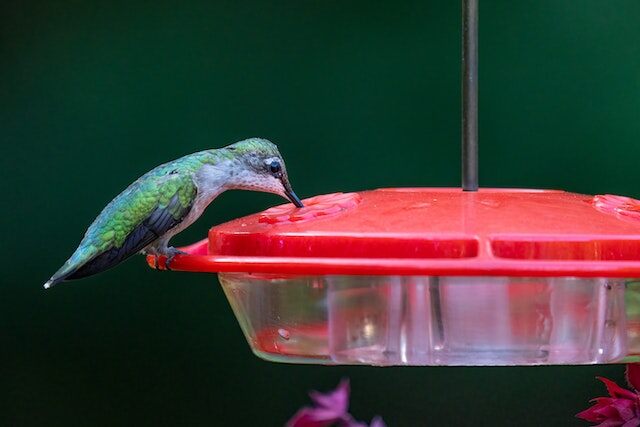
FAQs: How to Keep Bees Off Hummingbird Feeder?
Why are bees attracted to hummingbird feeders?
Bees are naturally drawn to the sweet scent of nectar, and hummingbird feeders provide an abundant source of this sugary substance. The bright colors of the feeder and the movement of the birds also act as additional attractions for bees.
Q: What are bee-proof hummingbird feeders?
Bee-proof hummingbird feeders are specifically designed to prevent bees from accessing the nectar while still allowing hummingbirds to feed. These feeders typically have features such as bee guards, built-in ant moats, or protective screens that create barriers for bees.
How do I install bee guards on my hummingbird feeder?
Bee guards are small attachments that can be added to the feeding ports of hummingbird feeders. To install them, simply follow the instructions provided with the bee guards. Typically, you will need to remove the feeding ports, slide the bee guards over the ports, and secure them in place. Make sure they are snugly fitted to create a barrier that bees cannot penetrate.
Are there natural deterrents to repel bees from hummingbird feeders?
Yes, there are several natural deterrents that can help repel bees from your hummingbird feeder. Some options include using essential oils with scent profiles that bees find unappealing, placing vinegar-soaked cotton balls near the feeder, or hanging water-filled bags to create a visual deterrent. These natural deterrents can be effective in deterring bees from your feeder.
Can the placement of my hummingbird feeder minimize bee activity?
Yes, the placement of your hummingbird feeder can greatly impact its attractiveness to bees. It is recommended to hang the feeder in a shaded area as bees are less likely to be attracted to the nectar in cooler conditions. Additionally, placing the feeder away from other food sources, such as flowering plants, can help reduce bee activity around the feeder.
How can I attract hummingbirds away from bees?
To attract hummingbirds away from bees, you can provide alternative food sources for them. Planting bee-friendly flowers in your garden can offer additional nectar sources for hummingbirds. You can also hang separate feeders filled with homemade nectar solutions away from the main bee-attracting feeder to divert the hummingbirds’ attention.
How often should I clean my hummingbird feeder?
It is recommended to clean your hummingbird feeder at least once every few days, especially during hot weather when nectar can spoil quickly. Regular cleaning prevents the buildup of mold, bacteria, and other contaminants that may deter hummingbirds and attract bees.
How can I prevent wasps from becoming a nuisance on my hummingbird feeder?
To prevent wasps from becoming a nuisance, you can try hanging wasp traps near the feeder. These traps can be filled with a sweet liquid to attract and trap the wasps. Regularly emptying and cleaning the traps will help maintain their effectiveness.
What are some additional tips to deter bees from hummingbird feeders?
In addition to the methods mentioned earlier, you can use decoy feeders filled with plain water to divert bees’ attention away from the main nectar-filled feeder. Creating physical barriers around the feeder, such as using mesh netting or placing sticky substances on nearby surfaces, can also discourage bees. Natural bee repellents like mint plants or citrus peels can be strategically placed near the feeder to discourage bee activity.
How can I support pollinators while keeping bees away from my hummingbird feeder?
While it is important to deter bees from your hummingbird feeder, it is also crucial to remember the importance of bees as pollinators. You can support pollinators by planting bee-friendly flowers in your garden, avoiding the use of pesticides that are harmful to bees, and providing nesting habitats, such as bee hotels, for solitary bees. These practices can create a pollinator-friendly environment while still maintaining a bee-free feeding station for hummingbirds.
What should I do if I still encounter persistent bee problems on my hummingbird feeder?
If you are still experiencing persistent bee problems, you can try troubleshooting common issues. This may involve adjusting the placement of the feeder, changing the type of feeder you use, or trying different deterrent methods. By implementing these troubleshooting tips, you can work towards maintaining a bee-free hummingbird feeding station.

